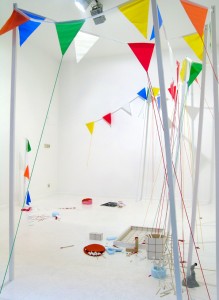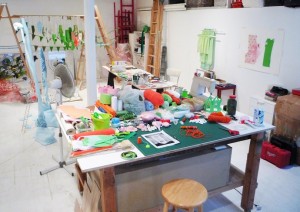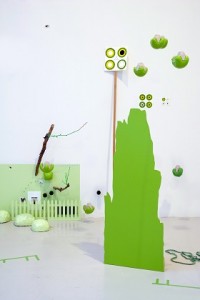Artist Statement
………..once upon a time there was a world: whimsical, humorous, credulous, synthetic, intimate, alien, glittering, soft, innocent and childlike, humming and obscure……….
Materials, found, everyday objects and colorful, decorative supplies overflow the categorized shelves and bins in my studio. In fabricating these fairy-like worlds, I knit, cut, glue, sew, find, draw, construct, select, saw, paint, decorate, carve, combine and mold. Initially I begin the process of the work with a material, a feeling, a color, or a vague image. Obscure, intangible thoughts and sensations collect within my mind and my body and step-by-step the work evolves, develops while making. In my work I am going on a journey, seeking to surprise myself.
There are no words for what I am going to do. Things come together – one stone goes on top of the next – it feels like building.
My work incorporates fictional narratives, dream worlds with anchors in the real, occupy a space between familiarity and fantasy. These environments are systems – overlapping worlds, groups and subgroups that are juxtaposed and united through scale, color palette, form, space, and material. With the continuous pushing and pulling among the elements of this vocabulary, I am creating hierarchies of events and narratives, which compete and communicate. These multiform assemblages result in playful, mysterious landscapes enticing the viewer into visual narrative journeys often with a strong sense of foreboding. I develop pathways for the viewer to travel. I link micro with macro worlds, encourage a sense of irritation, and implied movement of objects, and ask the viewer to relate themselves to the forms and the situations that they present.
I am interested in creating environs in which the viewer experiences personal associations; allowing them to feel, to dream, to fantasize, to be irrational, subjective and intuitive. Specific or vague personal memories are awakened.
The viewer is asked to weave his or her own story and sensations, to believe and to wonder.
Essay
Andrea Löfke — Between Vagrant Beauty and Soft Apocalypse
By Philipp Gutbrod
(Taken from the catalogue: Andrea Loefke – At home I go up the stairs, not down)
“The archetypal plant Urpflanze will be the world’s most extraordinary creation, for which nature itself will envy me. With this model and the key to it, one can then go on inventing plants forever that are consequentially coherent; that means, that even if they do not exist, they could exist, as they are not pictorial or poetic shadows or illusions, but rather possess an inner truth and necessity.”
Johann Wolfgang von Goethe to Johann Gottfried Herder, 17 May 1787
Entering an installation by the artist Andrea Löfke is like suddenly coming into contact with a natural phenomenon. A barrage of visual stimuli hits the viewer’s retina: a plethora of forms, materials and colors. Familiar motifs, at times morphed, intertwined with distorted shapes, bizarre inventions and found objects appear in mysterious and ambiguous settings. Always, there is a pull from the composition and its elements, the overall aesthetic enticing the viewer to come closer and to immerse himself in the artwork. The titles add to the seductive plot with exclamations such as “Oh do let me help to undo it!“ (PH Gallery, NYC, 2006). Löfke carefully structures the many cognitive layers of her works that unfold following the speed and intensity of an individual’s gaze. Once the primary stages of perception are traversed, the installations reveal their meaning. In an interview published in Sculpture magazine in 2008, Löfke precisely described the artistic intent of her work: “I want to create a place that interweaves the magical, the child-like, and the naive with lurid, mysterious, and abstruse elements. People bring their own stories, experiences, and personalities when viewing my work. I like to trigger sensations based on shared experiences with certain objects, materials, colors, textures, and ways of building and making.”
Common to most of her works, whimsical motifs from childhood’s realm stir up hidden longing for youthful playfulness. Löfke’s installations strategically target the regions of the mind that are beyond awareness and that spark emotional responses. This is achieved on the macro level by the sum of the elements and their composition in space, but an analysis on the micro level, of the single motifs, reveals the depth of Löfke’s art. The sheer quantity and visual power of the artist’s innumerable inventions mark her distinctive quality as a sculptor. Before setting out to focus mainly on installation art, back during her studies in Ohio around 2002, Löfke created a large number of small sculptural objects. These at times abstract, yet familiar, colorful, outlandish, playful pieces popped up from her imagination and from childhood memories. Due to Löfke’s precise technical ability, she was able to give form to whatever emerged from her subconscious and to select the perfect material. These many inventions served as ‘vocabulary’ for the installations to come. Soon, the pool of forms was enlarged by found objects, everyday items from different areas of daily life: home, school, hospital, restaurant, etc. A staple of Americana turned out to be an especially fruitful hunting ground for Löfke: the 99-cent store. With its cheap and colorful basic items and occasional kitsch vernacular, the instantly recognizable objects have become a main component of the artist’s ‘palette’ and are used to lead or mislead the viewer through the layers of her artworks. Just as Henry Moore’s maquettes were not only scale models for larger sculptures but also found objects like bones and rocks, Löfke’s ‘maquettes’ can easily stand on their own as artworks. Often, a chance encounter with an object or a material inspires a whole installation.
Löfke’s process of creating her installations is that of a sensitive membrane: no plan, artistic concept, visual theory or any other preconceived notion is carried into the empty exhibition space. The artist begins from scratch every time. Without the aid of assistants, all elements of an installation are placed and arranged by Löfke’s hand. It is a flow of creation, riffing off a room’s character, feeding off the haptic qualities of new materials, a three dimensional improvisation. Löfke’s work always appears organic: Art as Nature’s parallel creation, “grown” not constructed, rather evolved than created, and therefore possessing the aforementioned “inner truth and necessity.” An underlying intensity and even darkness to the vagrant beauty of her works can be found, seemingly adaptations rooted in a struggle for existence. Similar to a Venus Flytrap, the assembled objects, with their baby blues and ruby reds, pull the spectator in to reveal, in close proximity, razor-sharp edges, bleeding wounds, obscure pills, the sudden suppression of an unbearable lightness of being. As with all installations, Löfke’s works must be experienced and can only vaguely be conveyed in photographs, as the interplay of micro and macro levels constantly evolves in the eye of the beholder.
In 2003, with “Beneath such dreamy weather,” the artist began to expand her concept of installation and introduced an interactive component. From this point on, Löfke has created several works that present the viewers with concrete tasks they must fulfill to fully experience the work. For example, in “The squirrels, hedgehogs and rabbits are indeed harmless” (Michael Steinberg Gallery, NYC, 2007), the gallery space resembled a biosphere full of vegetation, architectural and abstract elements, blackboards, Band-Aids, pictures, signs, notes and drawings. Amidst these elements, all boasting an artificial green color, towered an eight-foot high platform, a deer stand. After ascending this structure, the viewer found at the top a soft welcoming cushion and a pair of binoculars with which the world around could be explored. The binoculars brought various details into focus and greatly enhanced the play of different scales: tiny trees growing out of a wall, targets referring to the viewer as hunter, abstract forms hanging from the ceiling, a mélange of inanimate and animate objects. Again, the at-first-glance idyllic scene beckoned the viewer to enter the space and (freed from the commitments of daily life) to linger, only to find an array of self-reflections spanning pleasant and concerning observations.
With her installation “Andrea’s Home Sweet Home + cooking session” (HomeBase Project III, NYC, 2008), Löfke took the concept of participation to the next level by, herself, taking on an active roll in the completed work. In great unison, the artist interacted with the viewers during the exhibition by cooking meals for everyone and thereby creating a homely environment. In addition, the viewers were provided with crayons and paper to make drawings and were also able to tend to the (real) flowers with a watering can. This fusion of artworks and action was set in a hyper stylized red and white checkered fantasy, an aesthetic overload, transporting the viewers into a state of unstable bliss.
The organic quality of Löfke’s work is greatly heightened by the active participation of the viewer, an extension of the artistic process. In her many ‘nurturing’ environments, with great subtlety, the notion of ‘safe’ in the current socio-economic and environmental field is challenged. Löfke herewith executes gentle incisions into the century-old questions of interaction between artist, work and viewer, establishing her as one of the most nuanced installation artists of her generation.
Darmstadt, October 2011
Das muss gefeiert werden! Mit Krokant, Kandiszucker, Kremhütchen und Konfekt! (Let us celebrate! With brittle, rock candy, pastry and confection!), August 2006. Mixed-media installation. Dimensions variable, 98 x 138 x 208 inches, installed.
Löfke’s studio during preparations for Zuhause gehe ich die Treppe rauf statt runter (At home I go up the stairs, not down), July 2009.
The squirrels, hedgehogs and rabbits are indeed harmless, November 2007. Mixed-media installation. Dimensions variable; 18 x 8 x 17 feet, installed.




